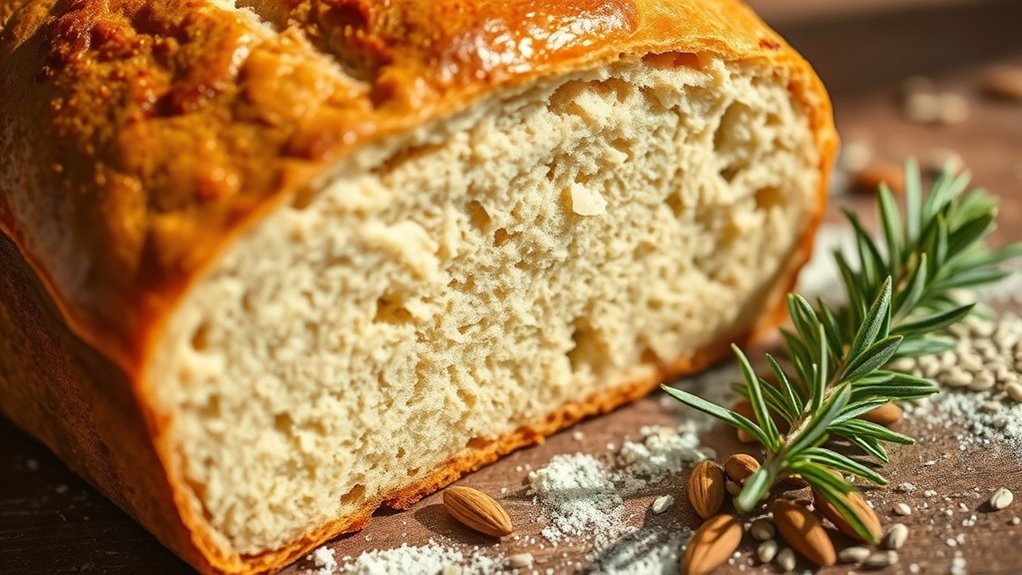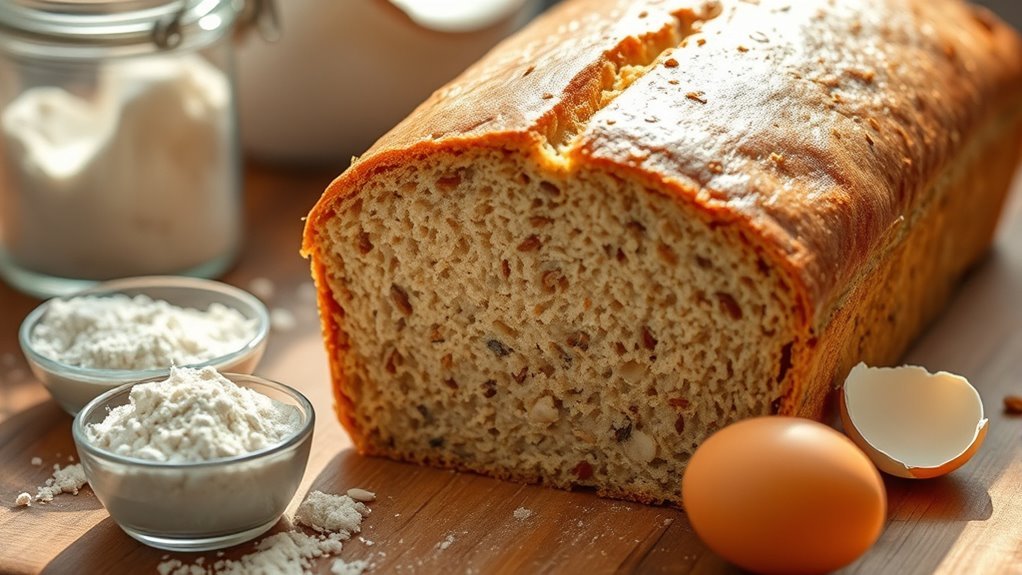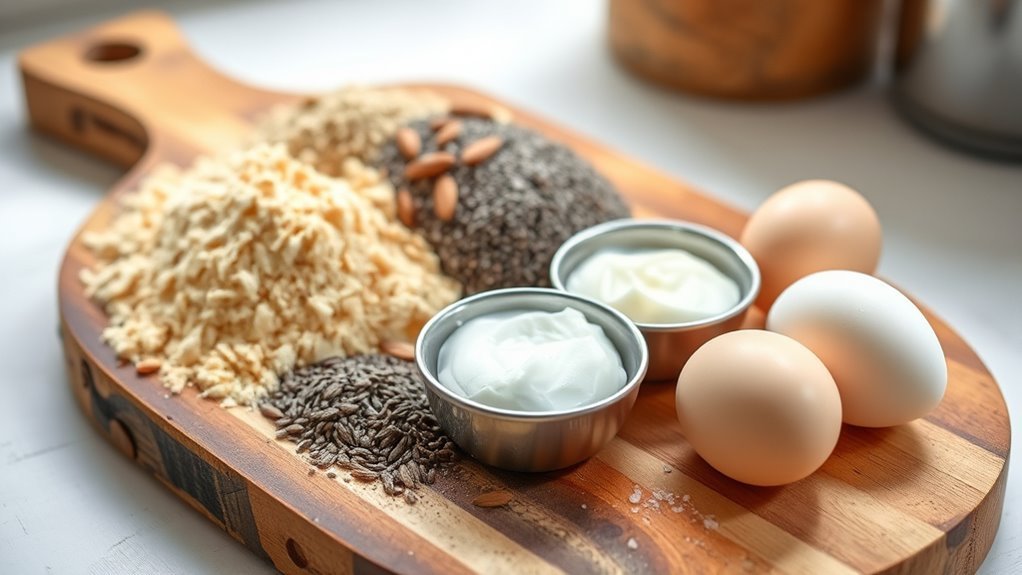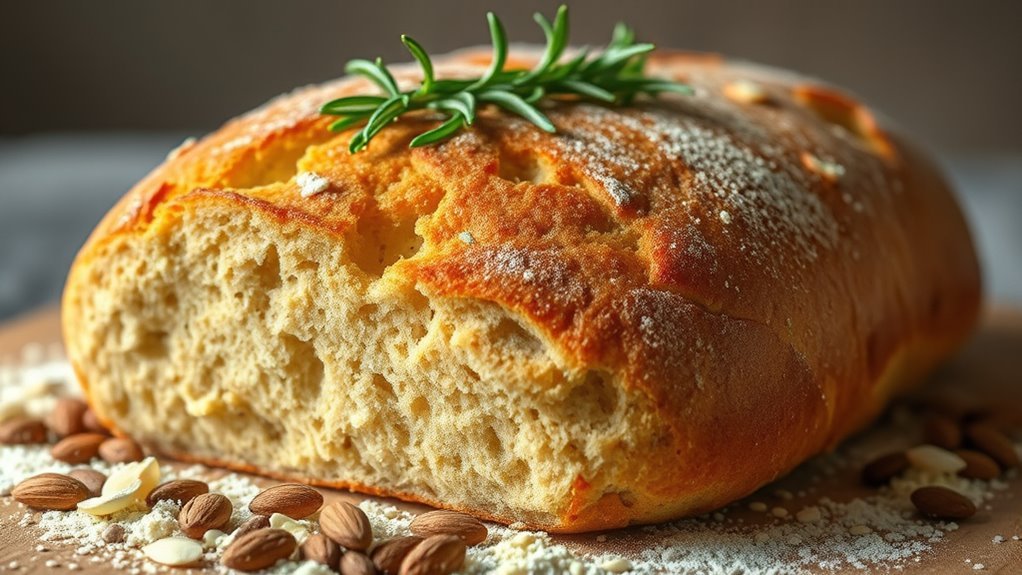Keto bread is made primarily from low-carb ingredients like almond flour and coconut flour, which serve as the foundation. Eggs act as the binding agent, providing moisture and richness. Psyllium husk adds fiber and structure, helping create a chewy texture. Baking powder provides leavening for a light finish, while cheese enhances flavor and moisture retention. Sweeteners, like erythritol or stevia, keep the bread deliciously sweet without the carbs. Discover how these elements work together for tasty results.
Almond Flour: The Foundation of Keto Bread

Almond flour serves as the cornerstone of keto bread, providing a low-carb alternative to traditional wheat flour. Its nutritional benefits are impressive; it’s rich in healthy fats, protein, and fiber while being low in carbohydrates. This makes it an excellent choice for those seeking to maintain stable blood sugar levels. When using almond flour, you’ll want to master specific baking techniques, like adding eggs or binding agents to achieve the right texture. Experimenting with different ratios can yield delightful results, allowing you to create bread that’s both satisfying and delicious. By incorporating almond flour into your recipes, you’re not just opting for a healthier alternative, but also embracing the freedom to enjoy bread without guilt while adhering to a ketogenic lifestyle.
Coconut Flour: A Low-Carb Alternative

While almond flour provides a fantastic base for keto bread, coconut flour is another excellent low-carb alternative that deserves your attention. This gluten-free option is incredibly absorbent, meaning you’ll need less of it compared to almond flour. When you use coconut flour, you’ll also enjoy its coconut health benefits, such as improved digestion and a boost in healthy fats. Plus, it’s rich in fiber, making it a satisfying ingredient for your keto diet. There are numerous coconut flour recipes available, from fluffy pancakes to delectable muffins, offering variety while keeping your carb count low. Incorporating coconut flour into your baking repertoire not only enhances flavor but also aligns with a healthier lifestyle. Enjoy the freedom of delicious, low-carb baking!
Eggs: The Binding Agent

When you’re crafting keto bread, eggs play an essential role as the binding agent that holds all the ingredients together. The binding properties of eggs come from their proteins and fats, which create a cohesive structure that enhances the texture of your bread. Different egg types, like large or extra-large, can affect your recipe’s outcome, so it’s important to choose wisely. For instance, using whole eggs provides both moisture and richness, while egg whites can lighten the texture. Not only do they help in binding, but eggs also contribute to the overall nutritional value, offering protein and healthy fats. By understanding the role of eggs, you can achieve a satisfying keto bread that meets your dietary goals and cravings.
Psyllium Husk: Adding Fiber and Structure
Psyllium husk is an essential ingredient in keto bread, providing both fiber and structure that enhance the texture. This soluble fiber not only aids digestion but also helps to create a chewy consistency, mimicking traditional bread. By incorporating psyllium husk, you can enjoy a low-carb bread option that satisfies your cravings while supporting your overall health.
Benefits of Psyllium Husk
If you’re looking to enhance the nutritional profile of your keto bread, incorporating psyllium husk can be a game-changer. This natural fiber supplement not only adds structure but also brings several psyllium husk benefits that support your overall well-being. Here are three key advantages:
- Digestive Health: Psyllium husk promotes regular bowel movements and can alleviate constipation, making it a great aid for digestive health.
- Satiety: Its high fiber content helps you feel fuller for longer, which can assist in managing cravings and maintaining your weight.
- Blood Sugar Control: Fiber can help stabilize blood sugar levels, making it beneficial for those on a keto diet.
Incorporating psyllium husk into your recipes guarantees you enjoy tasty keto bread while reaping these health benefits.
Role in Keto Bread
Incorporating psyllium husk into your keto bread recipes not only enhances the texture but also considerably boosts the bread’s fiber content. This ingredient plays an essential role in low carb baking by providing structure and elasticity, mimicking the properties of gluten. You’ll find that using psyllium husk contributes to the keto bread benefits, such as improved digestion and increased satiety.
| Benefits | Description |
|---|---|
| Enhanced Texture | Creates a soft, bread-like consistency |
| Increased Fiber | Supports digestive health |
| Improved Structure | Helps hold the bread together |
| Low Carb Solution | Perfect for your ketogenic lifestyle |
With psyllium husk, you can enjoy delicious, guilt-free keto bread.
Baking Powder: The Leavening Agent
While many might overlook it, baking powder plays an essential role as the leavening agent in keto bread recipes. It helps your bread rise, creating that light, airy texture you’re after. When you’re exploring leavening techniques, here’s why baking powder is a go-to choice:
- Quick Reaction: Unlike yeast, baking powder reacts instantly when mixed with wet ingredients, speeding up the baking process.
- Convenience: It eliminates the need for proofing or waiting, making it a simple baking alternative for busy cooks.
- Versatility: You can easily adjust the amount in your recipes, allowing for experimentation without compromising flavor.
Using baking powder effectively can transform your keto bread experience, giving you the freedom to enjoy delicious, fluffy loaves without the carbs.
Cheese: A Unique Ingredient for Texture
When it comes to keto bread, cheese isn’t just a flavor booster; it plays an essential role in enhancing texture. Varieties like mozzarella and cream cheese can create a chewy, satisfying mouthfeel while also contributing to the overall flavor profile. Understanding how different cheeses interact with other ingredients can elevate your keto baking game considerably.
Cheese Types Used
Cheese is a game-changer in keto bread recipes, providing not only flavor but also essential texture. When choosing cheese for your keto bread, consider these types:
- Mozzarella Varieties: Low in carbs and high in moisture, mozzarella adds stretchiness and a delightful chewiness to your bread.
- Cream Cheese: This rich cheese contributes creaminess and helps bind ingredients, creating a soft, tender crumb.
- Parmesan: Aged and flavorful, Parmesan adds a nutty taste and can enhance the overall flavor profile of your bread.
Texture Enhancement Benefits
Incorporating cheese into your keto bread not only elevates flavor but also markedly enhances texture, making it a unique ingredient in the baking process. Cheese contributes to texture improvement through its ability to create a soft, chewy crumb while retaining moisture. This moisture retention is essential, as it helps keep your bread fresh and enjoyable longer.
| Benefit | Description | Emotional Impact |
|---|---|---|
| Texture Improvement | Soft, chewy texture enhances enjoyment | Feelings of satisfaction |
| Moisture Retention | Keeps bread fresh longer | Reduces waste and regret |
| Flavor Pairing | Complements various ingredients | Invokes culinary creativity |
| Versatility | Works in various recipes | Encourages experimentation |
| Nutritional Boost | Adds protein and calcium | Supports health and wellness |
Flavor Profile Contribution
The incorporation of cheese not only enhances the texture of keto bread but also greatly contributes to its flavor profile. By utilizing cheese, you can experience a range of flavors that complement the low-carb ingredients, leading to a more satisfying bread experience. Here are three key benefits of cheese in keto bread:
- Umami Boost: Cheese adds a savory depth that can elevate the taste, making it more appealing.
- Flavor Balancing: Different cheeses can help balance other flavors, aligning with keto flavoring techniques to achieve harmony.
- Moisture Retention: The fat content in cheese contributes to moisture, preventing a dry texture often found in gluten-free alternatives.
Using these flavor balancing methods, cheese transforms keto bread into a delicious option that doesn’t compromise on taste.
Sweeteners: Keeping It Low-Carb
While you’re crafting your keto bread, choosing the right sweetener is essential for maintaining a low-carb diet. Low carb sweeteners like erythritol, stevia, and monk fruit are popular options that won’t spike your blood sugar. Erythritol, a sugar alcohol, is particularly favored for its zero-calorie content and similar texture to sugar. Natural sweeteners, such as stevia and monk fruit, offer sweetness without the carbs, making them perfect for keto baking. These alternatives not only keep your bread deliciously sweet but also align with your health goals. Always check labels for hidden sugars and carbs, ensuring you’re staying true to your keto lifestyle. Your choice of sweetener can make all the difference in enjoying your bread guilt-free!
Additional Flavorings: Herbs and Spices for Taste
Sweeteners aren’t the only way to enhance the flavor of your keto bread; herbs and spices can elevate your baking game too. By carefully evaluating herb selection and spice combinations, you can create a loaf that’s bursting with flavor while still keeping it low-carb. Here are three great options to evaluate:
Enhance your keto bread with herbs and spices for a flavorful, guilt-free delight!
- Rosemary: This herb adds a fragrant, earthy note that complements various breads.
- Garlic Powder: A little goes a long way, providing a savory punch that enhances the overall taste.
- Cinnamon: Perfect for sweet keto bread, it can satisfy your sweet tooth without the added carbs.
Experimenting with these ingredients can transform your keto bread into a culinary delight, allowing you to enjoy every bite guilt-free!


